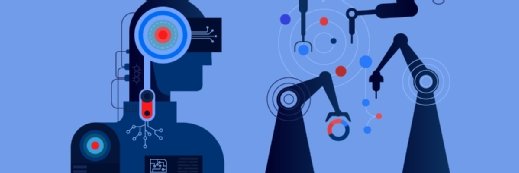
putilov_denis - stock.adobe.com
Advanced technologies fuel supply chain 'magic conveyor belt'
In this Q&A, MIT's Yossi Sheffi discusses the complexities of modern supply chains and how AI, automation and robotics will affect the future of supply chain employment.
In the wake of the COVID-19 pandemic, supply chains became a topic of interest in a way that they never had before. Customers and companies took for granted that goods would arrive on schedule to the home, store shelf or factory floor.
However, events like the pandemic and Russia's invasion of Ukraine exposed the reality: supply chains are complex and fragile. But they could also become resilient as supply chain managers implemented new technologies and processes to keep goods moving.
In his new book The Magic Conveyor Belt: Supply Chains, A.I. and the Future of Work, Yossi Sheffi explores the new world of supply chains and the future of supply chain work.
Sheffi is the Elisha Gray II professor of engineering systems at MIT and director of the MIT Center for Transportation and Logistics. He has researched and written about supply chain technologies, transportation and logistics for more than 40 years.
Here, Sheffi discusses the nature of today's complex supply chains and how technologies like AI, automation and robotics will affect the future of supply chain processes and employment.
Editor's note: The following has been edited for length and clarity.
Can you explain the complexity of today's supply chains?
 Yossi Sheffi
Yossi Sheffi
Yossi Sheffi: The average car has about 30,000 parts, and they all have to get into the plant just in time. If one thing is missing, you can't build the car. Supply chain is the series of processes, maybe from a mine in China or Kazakhstan, to a finished product on the shelf or in an Amazon warehouse. A company like Ford has about 2,000 direct suppliers, and each of those suppliers has hundreds of sub-suppliers that have their own sub-suppliers, so the supply chain mushrooms very quickly. It's not surprising that people don't know what's happening in the bowels of the supply chain in the third, fourth and fifth tier. The fact that they don't know makes for surprises when something cannot be done or there's a disruption that creates a shortage in the supermarket shelf.
How fragile is this complex supply chain?
Sheffi: Everything has to work to get to that shelf. People shouldn't be mad when something is not on the shelf. They should be surprised that something is on the shelf, and they have to understand what it takes to get there. That's what I call the magic conveyor belt that brings goods from [raw materials] to a finished product.
Why did people only start to notice this during the pandemic?
Sheffi: There were disruptions that were noticed, but the effects were relatively small. The Fukushima disaster [in Japan in 2011] was not a small event. But after it, there were certain cars you couldn't buy, like a black Audi. You can live without a black Audi. But toilet paper is much harder to live without. What happens in these cases is when you start to get shortages, consumer panic sets in because the media hypes it up. People started overbuying and they overwhelmed the ports -- they overwhelmed the whole the whole supply chain.
How can AI be used in supply chain technology and processes?
Sheffi: AI runs the advanced robots that are used in warehouses. In forecasting, people are using machine learning to take more data and more factors into account. For risk management, if you want to get an alert of when a supplier may be in trouble, you can look at backward facing data. But unfortunately this is past data. If you want to get a real warning, you should look at current media. If there are cases where executives are leaving a company or they didn't finish a merger or acquisition, it's a sign that the executives are not paying attention to the business. But to do this, you have to use ML that can do language processing on a large scale to look all over the internet and media to give you an inkling that you have to pay attention to that company.
Can you do that without AI?
Sheffi: It would be hard to do because you would need hundreds of people to read the papers and reports. You can't process language the way that ML can process language now. Computers were used to process numbers; now we can process language and text as well as images and pictures. It's a quantum step up in the ability of the machinery.
How will AI like ChatGPT change the nature of work in the supply chain?
 The Magic Conveyor Belt:
The Magic Conveyor Belt:
Supply Chains, A.I. and
the Future of Work
Sheffi: There's a big debate about what will happen to jobs with AI, ChatGPT and -- in general -- technologies like robotics and automation. There are two minds. There are people who think it's Armageddon, and they're not sure what society will look like in 15 to 20 years. I'm in the other camp that thinks all this technology can usher in a new era of prosperity.
Let's look at ChatGPT for example, but first think about spreadsheets. Before spreadsheets, people in companies had to develop a financial model and had to work with programmers to code it. Now they just get data and put it into a spreadsheet. ChatGPT is a tool. You need to have people who know how to query the GPT and, most importantly, how to judge the results. It makes awful mistakes -- not often, but it invents stuff that's just wrong.
What lessons can we learn from the history of new technologies and employment?
Sheffi: If you look at history, there's always a fear of losing jobs with new technology. But every time, more jobs are created than eliminated. Some of this is hard to predict. The Ford production line simplified car production, and the employment at Ford skyrocketed from several hundred to over 150,000. But the big change was that cars became cheaper, people started driving, and motels and restaurants opened all over the United States. Millions of jobs were created because people were able to drive. When Ford started the production line, they weren't thinking about the invention of motels or restaurants.
So the effects of new technologies or processes are often unpredictable?
Sheffi: These side effects are hard to predict. The fear is understandable because we know that jobs will change and that people may lose their jobs or have to retrain. What we don't know is what the new jobs will be like. Twenty years ago, nobody thought there would be a job like optimizing the advertisements on Google.
When the ATM came about, there were about 300,000 bank tellers in the U.S., and there were articles saying there'll be no more tellers. But there are now more than 600,000 tellers. Why? Banks didn't need as many tellers, opening a bank branch became cheaper and the number of tellers actually went up overall. It's hard to predict because every new technology looks like magic until you understand it.
The first PCs seemed like magic. Fifty years ago when people were connected through telephone exchanges, if you described something like Zoom, it would have been unthinkable. What AI does is hard to understand, and nobody really knows what will happen. You have to go to history to get parallels to understand what might happen with the technology.
Jim O'Donnell is a senior news writer who covers ERP and other enterprise applications for TechTarget Editorial.






